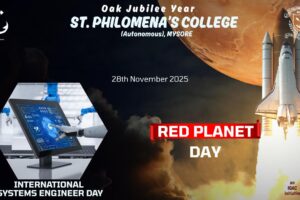
INSTITUTIONAL VISIT TO INDIAN INSTITUE OF SCIENCE(IISc), BANGLORE.
INSTITUTIONAL VISIT TO I
Introduction: The students of Biological Sciences, specializing in Biochemistry, had the privilege to visit the renowned Indian Institute of Science (IISc) in Bangalore on an open day event. The visit aimed to provide students with an opportunity to explore the cutting-edge research and facilities available at IISc, as well as to gain insights into various scientific models and concepts.
- Exhibition of Scientific Models:
- Upon arrival, students were mesmerized by the extensive exhibition of scientific models showcasing various aspects of biological sciences. These models ranged from molecular structures to complex biological systems, providing a comprehensive overview of ongoing research at IISc.
- The IISc representatives meticulously explained each model, elucidating its significance in current research endeavors. Students were particularly intrigued by the innovative approaches employed in understanding biological phenomena.
- Interactive Presentations:
- Engaging presentations were organized on diverse topics within Biochemistry, including enzyme kinetics, molecular biology techniques, and protein structure-function relationships. The experts from IISc elucidated these concepts with clarity and enthusiasm, fostering a stimulating learning environment.
- Students actively participated in discussions, posing insightful questions and gaining valuable insights into the theoretical frameworks and practical applications of Biochemistry.
- Laboratory Tours:
- A highlight of the visit was the guided tours of state-of-the-art laboratories at IISc. Students had the opportunity to witness firsthand the sophisticated instrumentation and experimental setups utilized in cutting-edge research.
- The researchers and technicians provided detailed explanations of ongoing projects, experimental methodologies, and the significance of their findings in advancing the frontiers of Biochemistry.
- Interactions with IISc Personnel:
- Throughout the day, students engaged in meaningful interactions with faculty members, researchers, and graduate students at IISc. These interactions provided valuable insights into academic and research opportunities available at the institute, inspiring students to pursue further studies in Biochemistry.
- The IISc personnel shared their experiences, research interests, and career trajectories, motivating students to aspire for excellence in their academic and scientific pursuits.
List of the models from Biological sciences Department

Paper Chromatography is an analytical method used to separate coloured chemicals or substances. It is now primarily used as a technical tool, having been replaced in the laboratory by other chromatography methods such as thin-layer chromatography(TLC).There are five types of chromatographic methods, Descending, Ascending, Ascending-Descending, Circular chromatography, two dimensional. The main applications are fermentation,ripening, inspect cosmetics, reaction mixtures in BCH

Phototransduction is the process by which photosensitive cells in the retina convert light energy into an electrical impulse that is transmitted to the brain. Rods and cones are highly polarized photoreceptor cells that capture energy from photons and generate a neural response. Main key players which include phototransduction are proteins like rhodopsin and molecules like retinal which change shape when hit by light. This sets off a chain of events ultimately leading to the brain recognizinglight.GMP allows for the sensitization of photoreceptors cells down to the level of single-photon sensitivity. Nitric acid can stimulate producing of cGMP by interacting with the hem group of the enzyme soubleGuanylate Cylse(Sgc).
CENTRAL DOGMA

Within each cell the genetic information flows from DNA to RNA to Protein. This flow of information is unidirectional and irreversible. The information carried within the DNA dictates the end product(protein) that will be synthesized. This information is the genetic code. Conversion of DNA encoded information to RNA is called Transcription. The information from Mrna is then translated to an amino acid sequence in the corresponding protein. Only one strand of DNA serves as a template.
DNA——–>RNA——>Protein
Transcription Translation
Photos





CONCLUSION
- In conclusion, visiting Indian Institute of Science(IISc) in Bangalore from St. Philomena’s College was an enriching experience to the students and the faculties that provided valuable insights into cutting edge research, academic opportunities and collaborative possibilities.
- The exposure to state-of-the-art facilities, interactions with esteemed faculty members and engagement in stimulating discussions have undoubtedly broadened the perspectives and inspired the students to pursue excellence in their academic and research endeavours.
- This visit has not only strengthened their academic foundation but also instilled a sense of aspiration to contribute meaningfully to the scientific community.
NDIAN INSTITUE OF SCIENCE(IISc), BANGLORE.



